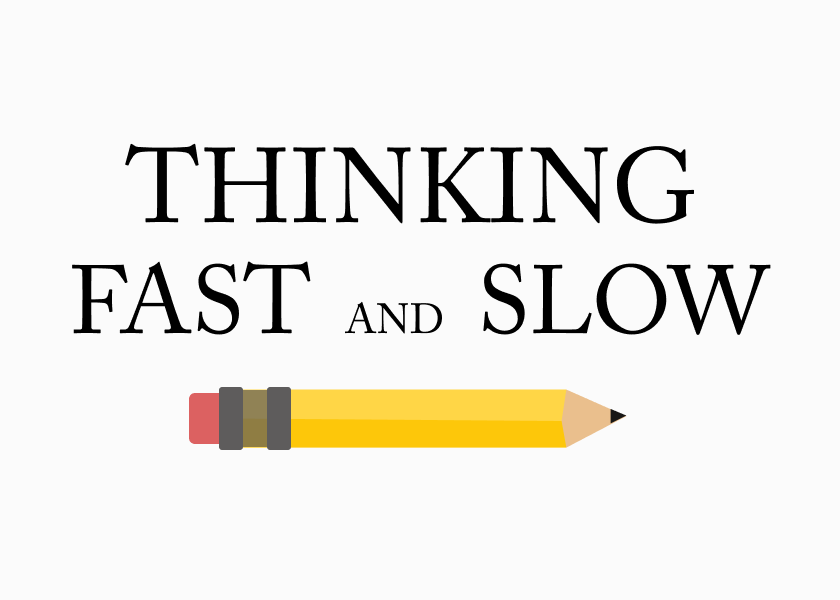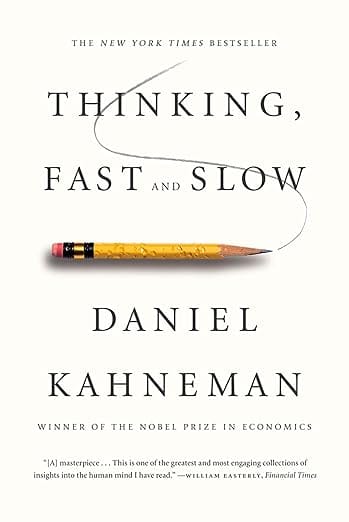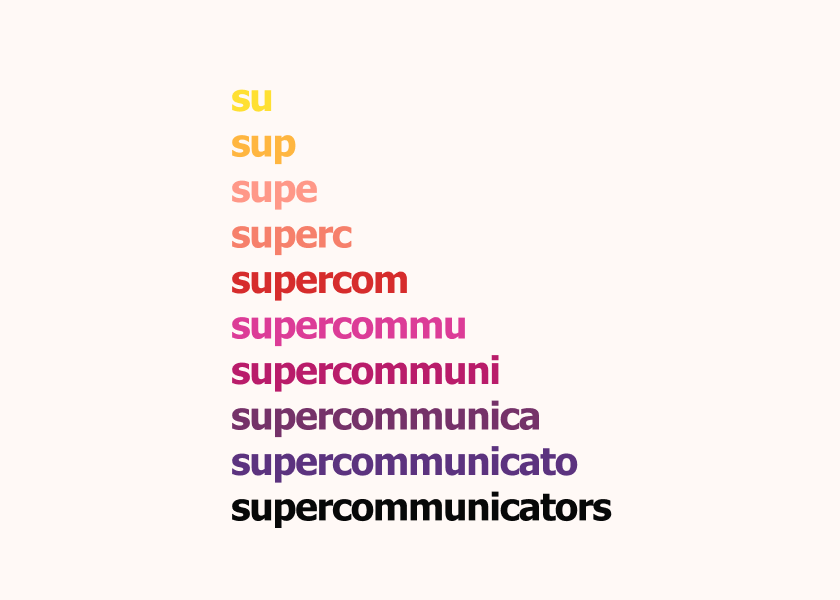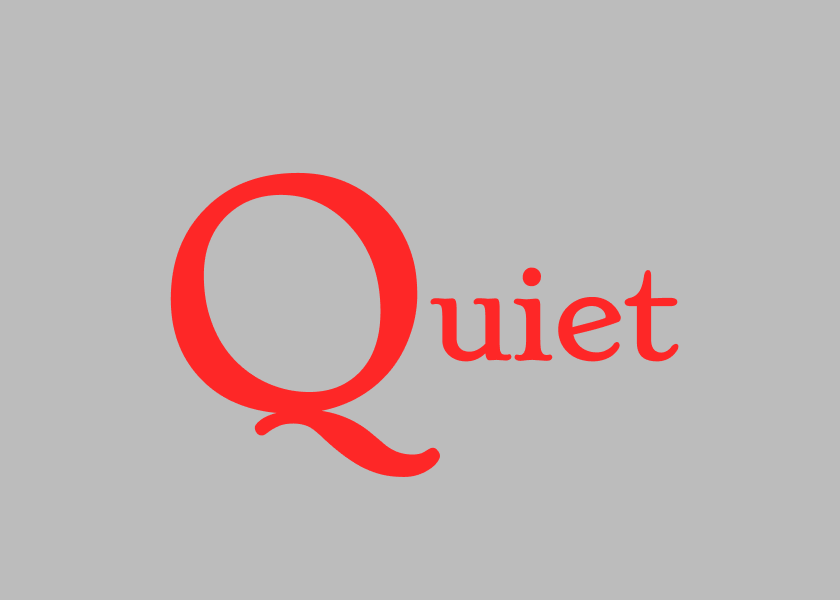Thinking, Fast and Slow by Daniel Kahneman - Summary
This book gives us insight into how our minds operate through two different systems: one fast and intuitive and one slow and logical. It also teaches us about what pitfalls this leads to and how to avoid them for better choices and decisions.

The following is a summary of the book Thinking, Fast and Slow by Daniel Kahneman.
Listen to ShelfHelp's podcast about the book Thinking, Fast and Slow.
Are Your Decisions Truly Your Own? Unveiling the Hidden Forces Shaping Your Choices
Have you ever wondered why you make certain decisions, even when they don’t seem logical? This book summary delves into the groundbreaking work of Nobel laureate Daniel Kahneman, offering a glimpse into the intricate workings of the human mind. In this summary, we’ll explore the core ideas from his acclaimed book Thinking, Fast and Slow, which has captivated readers worldwide with its profound insights. This article offers a comprehensive overview, saving you time while equipping you with actionable insights.
Table of Contents
- About the Author
- Who Should Read This Book?
- Key Insights and Themes
- Detailed Summary
- Review
- Actionable Takeaways
- FAQs
- Conclusion
About the Author
Daniel Kahneman, a Nobel laureate in Economic Sciences, is a renowned psychologist celebrated for his work on decision-making, cognitive biases, and behavioral economics. His research, often conducted in collaboration with Amos Tversky, has revolutionized our understanding of human judgment and has had a wide impact on multiple fields including medicine, law, finance, and military strategy. Kahneman's book, "Thinking, Fast and Slow," represents his current understanding of judgment and decision-making. It draws on decades of research and insights, providing readers with a profound understanding of the human mind.
Who Should Read This Book?
This summary is designed for anyone who wants to understand how their minds work and make better decisions. Specifically, this article will be of great value to:
- Professionals: Business leaders, managers, and entrepreneurs who need to make sound decisions under uncertainty. It offers insights into common biases that can affect strategic planning, hiring, and investment choices.
- Students and Researchers: Those in psychology, economics, or related fields seeking a foundational understanding of cognitive processes. The book presents the basic elements of a two-systems approach to judgment and choice.
- Individuals Seeking Self-Improvement: Anyone interested in improving their critical thinking skills and becoming more aware of their own decision-making biases. This text will help those who seek to understand the flaws of intuitive thought.
- Anyone Curious About the Mind: People fascinated by psychology and interested in understanding the science behind everyday decisions. The book is about the workings of System 1 and the influences between System 1 and System 2.
Key Insights and Themes
Here are the key takeaways, main ideas, and biggest lessons from "Thinking, Fast and Slow":
- Two Systems of Thinking: The book introduces the concept of two distinct systems of thought: System 1 (fast, intuitive, and emotional) and System 2 (slow, deliberate, and logical). These systems often compete for control over our thoughts and actions.
- Cognitive Biases: It explores common biases that lead to errors in judgment, such as the availability heuristic, anchoring effect, representativeness heuristic, and loss aversion.
- The Power of Priming: The book explains how subtle cues in our environment can unconsciously influence our thoughts and behaviors.
- Statistical Blindness: It highlights our difficulties in thinking statistically, explaining why we often overlook base rates and overemphasize anecdotal evidence.
- Overconfidence: It explains our tendency to overestimate what we know and underestimate the role of chance.
- Framing Effects: The way a problem is presented can drastically change our decisions, even when the underlying options are the same.
- The Experiencing Self vs. The Remembering Self: The book distinguishes between the self that lives experiences and the self that remembers them, revealing how they often evaluate situations differently.
- The Illusion of Understanding: The human mind creates narratives that are often simpler and more coherent than reality. This leads to overconfidence in our ability to predict the future.
Detailed Summary
The book is structured into five parts, each covering a key area of cognitive psychology and decision-making.
Part 1: Two Systems
- The Characters of the Story: Introduces System 1, which operates automatically and quickly with little effort and no sense of voluntary control, and System 2, which allocates attention to effortful mental activities.
- Attention and Effort: Discusses how attention and effort are limited resources and how our social behavior makes allowances for these limitations. Intense focus can make people effectively blind to stimuli that normally attract attention.
- The Lazy Controller: Explores how System 2 is often lazy and reluctant to invest more effort than necessary, frequently adopting the suggestions of System 1.
- The Associative Machine: Explains how System 1 continually constructs a coherent interpretation of what’s happening in the world through associative memory.
Part 2: Heuristics and Biases
- The Law of Small Numbers: Explores how we often draw overly confident conclusions from limited evidence, a consequence of System 1’s preference for coherence over accuracy.
- Anchors: Details how arbitrary numbers can influence our judgments, acting as cognitive anchors that constrain our thinking. Anchoring can be due to priming or insufficient adjustment.
- The Science of Availability: Explores the availability heuristic, where we assess frequency based on how easily instances come to mind. This can be influenced by personal involvement, mood and emotional state as well as media reports and self-sustaining chains of events.
- Tom W’s Specialty: Discusses how we often prioritize representativeness (similarity to stereotypes) over base rates, leading to incorrect probability judgments. Bayesian reasoning requires considering both base rates and specific evidence.
Part 3: Overconfidence
- The Illusion of Understanding: Explains how we create simplistic narratives of the past, giving us a false sense of understanding and predictability.
- Recipes for Success: Highlights how business books often exaggerate the impact of leadership and management practices, creating an illusion of control.
- The Illusion of Skill: Explores the idea that expert judgment is often no better than chance, and how simple formulas often outperform experts in predicting outcomes.
Part 4: Choices
- Bernoulli's Errors: Introduces prospect theory, which describes how people make decisions under risk. It explains how people evaluate gains and losses differently from a reference point.
- Loss Aversion: Discusses how losses loom larger than gains, making people more sensitive to potential losses than to potential gains.
- Framing and Reality: Explores how choices are affected by how they are framed.
Part 5: Two Selves
- Two Selves: Introduces the experiencing self (which lives in the present) and the remembering self (which evaluates the past), explaining how they often have different evaluations of events. The remembering self is more focused on significant moments and the end of experiences.
- Thinking About Life: Discusses the importance of the focusing illusion and how we often misjudge what will make us happy in the long term.
Review
Thinking, Fast and Slow is a comprehensive and thought-provoking exploration of the human mind.
Strengths:
- Comprehensive Coverage: The book covers a wide range of topics, providing a detailed understanding of cognitive psychology and behavioral economics.
- Practical Relevance: It offers numerous real-world examples and applications, making the complex concepts accessible and understandable.
- Rigorous Research: The insights are based on decades of scientific research conducted by Kahneman and other leading psychologists.
- Engaging Style: The book uses a storytelling approach, making it enjoyable and engaging.
Weaknesses:
- Length and Complexity: The book is lengthy and can be dense, requiring considerable effort to fully grasp all of the concepts.
- Repetitive in places: Some concepts are repeated in different contexts which might feel redundant at times.
- Overly focused on error: The book tends to focus on errors in thinking, without as much focus on accurate intuitions and how prolonged practice can result in expertise.
Actionable Takeaways
Here are a few ways you can apply the lessons from this book to your daily life:
- Slow Down Your Thinking: Recognize when you're relying too heavily on System 1, and activate System 2 for important decisions that require more deliberation.
- Be Aware of Biases: Actively look for biases in your thinking and challenge your assumptions. Use checklists and structured processes to minimize the influence of biases.
- Seek Different Perspectives: Try to gather diverse opinions and information to counteract the limitations of your own thinking.
- Use Statistical Thinking: Actively seek out base rates when making decisions and avoid being overly swayed by vivid anecdotes.
- Consider Framing: Be aware of how decisions are framed, and reframe problems to gain a clearer perspective.
- Reflect on Past Decisions: Review past decisions to identify patterns in your own errors in order to improve future decision-making.
- Use Premortems: Before starting a project, imagine it has failed and ask what might have gone wrong, which can help you identify potential issues early.
FAQs
- What is "Thinking, Fast and Slow" about? It explores the two systems of thinking that influence our decisions: the fast, intuitive System 1 and the slow, deliberate System 2. It also discusses cognitive biases and strategies for making better choices.
- Is "Thinking, Fast and Slow" worth reading? Yes, it is a valuable read for anyone interested in understanding how the mind works and making better decisions in all areas of life.
- What is the availability heuristic? It is a mental shortcut where we estimate the probability of events based on how easily examples come to mind.
- What is the anchoring effect? It is a cognitive bias where our judgments are unduly influenced by initial numbers or values we are exposed to.
- What is the purpose of System 1 and System 2? System 1 operates automatically and intuitively, while System 2 is more deliberate and analytical. System 2 can monitor and correct System 1, but is often lazy and doesn't do so.
- How can I reduce the impact of cognitive biases? By understanding them, seeking diverse perspectives, slowing down your thinking, using statistical data and checklists, you can reduce the effect of biases on your judgements.
Conclusion
Thinking, Fast and Slow offers a profound journey into the depths of the human mind, exposing the hidden forces that shape our decisions. By understanding how our two systems of thought interact and how biases influence our judgment, you can make more informed, rational choices. Start applying these insights today to gain a better understanding of yourself and the world around you. Don't wait to unlock your mind's potential—begin your journey towards improved decision-making now!
As an Amazon Associate, ShelfHelp may earn money from qualifying purchases. Needless to say, ShelfHelp only includes affiliate links to books we recommend and think are worth your time reading.




